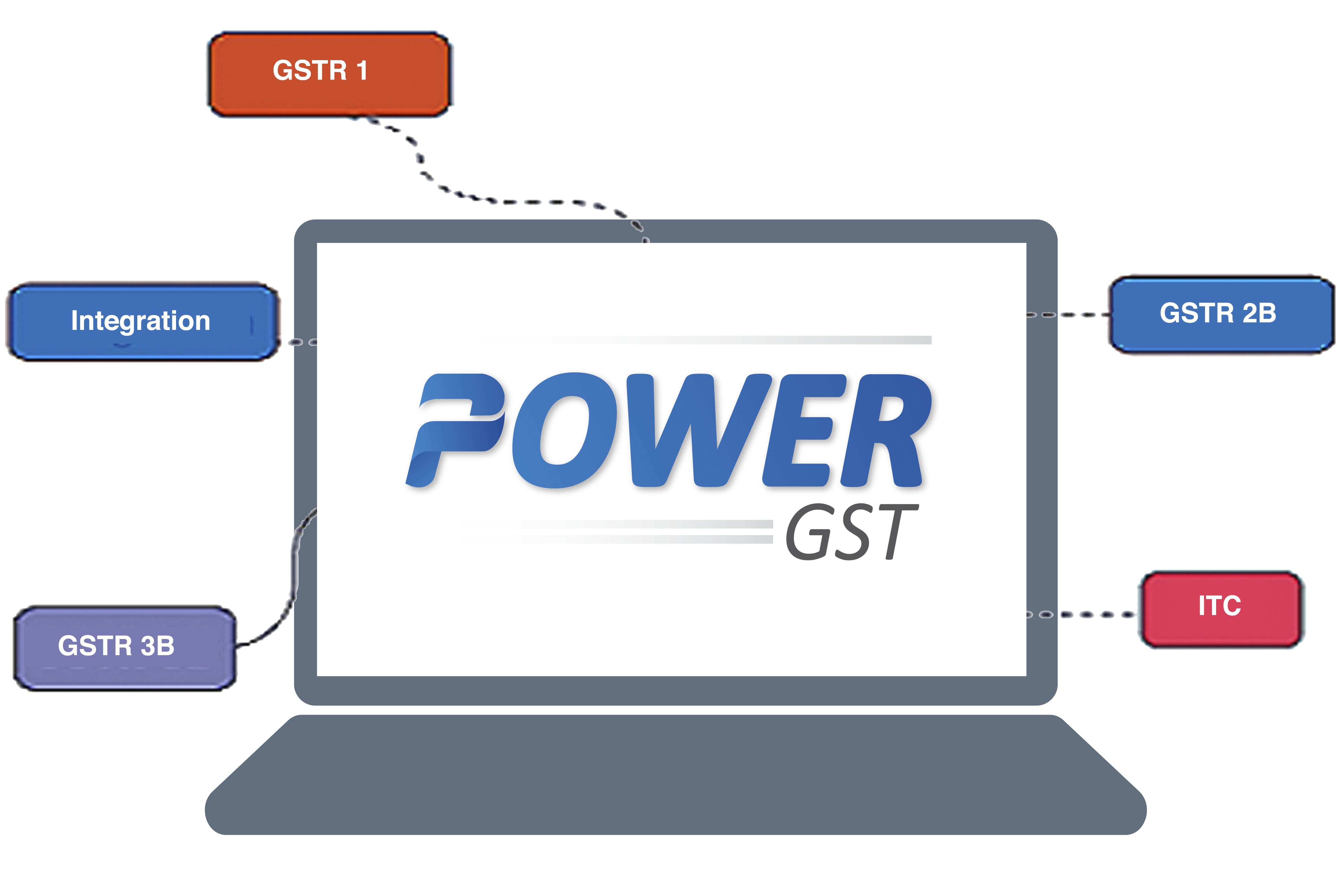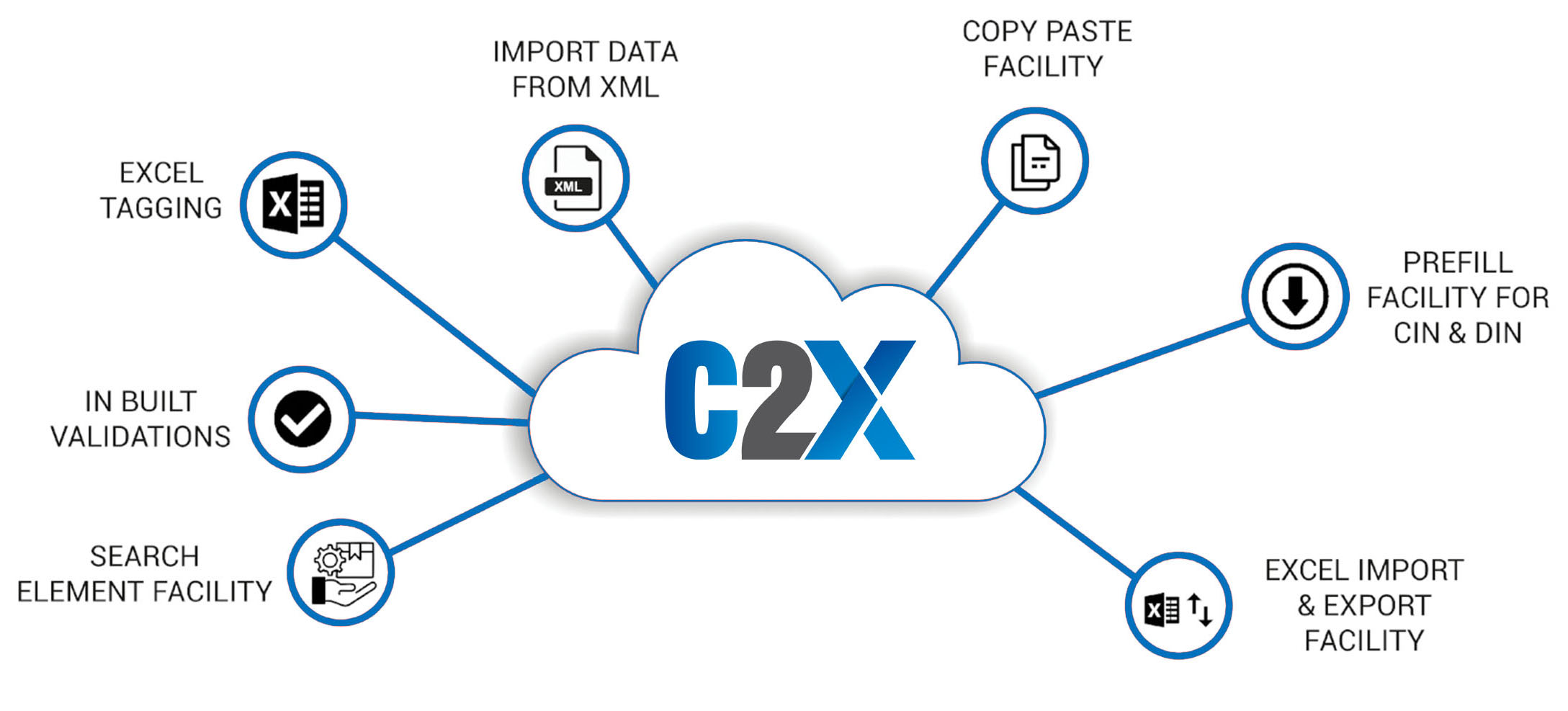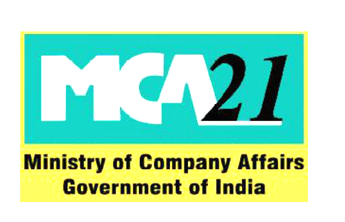Our Clients
Our Products
Our Solutions
APIs
PowerGST Software
GST return filing, Reconciliation & Reporting

India's Most Trusted & Fastest GST Filing Software!
Experience seamless GST Return Filing Software along with easy reconciliation of mismatched invoices and automatic data validation
- Import & Export
- Validations
- Powerfull Reconciliation
- Notification & Updates
- Dashboard
- Data Management
- Dedicated Customer Support
XBRL Filing Software
C2X Finance XBRL Software
India’s 1st Cloud based XBRL Software developed by IND-AS Taxonomy developer.
- Cloud Based Solution - Anytime - Anywhere Access
- Import Data from Previously Generated XML/XBRL File
- Excel Import & Export Facility
- Error Locator feature for Validation of errors
- Excel Tagging
Read More

We are Technology Partner of
Committed to security
Software & Solutions are Recognised & Recommended by
FAQ's on All Products?
GST software refers to a computer program or application designed to assist businesses in managing their Goods and Services Tax (GST) obligations. It streamlines and automates various tasks related to GST compliance, such as generating invoices, maintaining records, filing returns, and reconciling data. You need GST software to ensure accurate and efficient management of GST processes, reduce manual errors, save time, and stay compliant with the tax regulations.
GST software simplifies the process of generating GST-compliant invoices. It automatically calculates the applicable taxes, such as Integrated GST (IGST), Central GST (CGST), and State GST (SGST), based on the item details and tax rates. The software also includes relevant invoice fields like GSTIN (Goods and Services Tax Identification Number), HSN (Harmonized System of Nomenclature) code, and other required information. By using GST software, you can generate accurate invoices quickly, ensuring compliance with the GST rules and regulations.
Yes, GST software can significantly assist you in filing GST returns. It simplifies the process by automating the calculation of taxes, generating various forms such as GSTR-1 (for outward supplies), GSTR-3B (monthly summary return), and GSTR-9 (annual return), and providing error checks to minimize mistakes. Additionally, it can reconcile the data entered in purchase and sales registers, making return filing more efficient and accurate. With the help of GST software, you can streamline the return filing process and ensure timely compliance.
Yes, GST software is suitable for businesses of all sizes and across various industries. Whether you run a small business, a medium-sized enterprise, or a large corporation, GST software can cater to your specific needs. The software often offers customizable features to accommodate different business requirements, such as multi-user access, inventory management, e-way bill generation, and integration with other accounting systems. By choosing the right GST software, you can simplify GST compliance regardless of your business type or industry.
Yes, it is crucial to keep your GST software up to date. Regular updates ensure that the software remains compatible with the latest changes in the GST laws and regulations. Updates may include new tax rates, revised forms, updated validations, and bug fixes. By updating your GST software, you can ensure accurate calculations, smooth return filing, and compliance with the latest GST requirements. It is recommended to check for software updates periodically or opt for a software version that provides automatic updates to stay in line with the evolving GST landscape.
XBRL software refers to specialized tools and applications designed to create, validate, and analyze financial data in eXtensible Business Reporting Language (XBRL) format. XBRL is a standardized language used for electronic communication and exchange of business and financial information. XBRL software enables organizations to transform their financial statements and reports into XBRL format, making it easier to analyze, compare, and share financial information across different platforms.
XBRL software offers several benefits for businesses and financial institutions:
• Improved accuracy: XBRL software reduces the risk of manual errors and inconsistencies that can occur during data entry and conversion processes.
• Enhanced efficiency: By automating the conversion of financial data into XBRL format, the software streamlines the reporting process, saving time and effort.
• Standardized reporting: XBRL ensures consistency in financial reporting by following predefined taxonomies, allowing for easy comparison of data across different companies and industries.
• Regulatory compliance: Many regulatory bodies require the submission of financial statements in XBRL format, and using XBRL software ensures compliance with these regulations.
• Data analysis and insights: XBRL software enables users to extract valuable insights from financial data, perform trend analysis, and generate customizable reports for decision-making purposes.
XBRL software is suitable for businesses of all sizes, including small businesses. While larger corporations may have more complex reporting requirements, small businesses can also benefit from using XBRL software to streamline their reporting processes and comply with regulatory obligations. XBRL software solutions are available in various versions, ranging from basic tools for smaller businesses to more advanced platforms with extensive functionalities for larger corporations.
Yes, many XBRL software solutions are designed to integrate seamlessly with existing accounting systems. These software tools offer integration capabilities with popular accounting software such as QuickBooks, SAP, Oracle, and others. Integration allows for the direct extraction of financial data from the accounting system and its conversion into XBRL format without the need for manual data entry. This integration enhances data accuracy and reduces the time required for reporting.
The ease of use of XBRL software can vary depending on the specific tool you choose. However, most XBRL software solutions aim to provide a user-friendly interface and intuitive workflows to simplify the process of creating and managing XBRL filings. While some level of familiarity with financial reporting concepts and XBRL taxonomy may be helpful, many XBRL software tools offer comprehensive user guides, tutorials, and customer support to assist users in getting started. With a little practice and support, users can become proficient in using XBRL software without the need for extensive specialized training.
Digital signature software is a technology that allows users to sign electronic documents securely and legally. It uses cryptographic algorithms to create a unique digital signature that can verify the authenticity and integrity of a document. This software eliminates the need for physical signatures and streamlines the signing process, making it efficient and convenient.
Digital signature software works by using asymmetric encryption techniques. When a user signs a document using the software, it creates a unique digital signature by encrypting a hash of the document using the user's private key. This digital signature is attached to the document, and anyone with the corresponding public key can verify its authenticity and integrity by decrypting the signature and comparing it with the calculated hash of the document.
Yes, digital signatures are legally binding in many countries and regions around the world. They provide the same legal validity as traditional handwritten signatures, as they offer robust security measures to ensure the authenticity and integrity of signed documents. However, the legal recognition of digital signatures may vary depending on the jurisdiction, so it's essential to familiarize yourself with the specific laws and regulations in your region.
Yes, digital signature software can be used to sign a wide range of documents, including contracts, agreements, invoices, forms, and more. It is a versatile solution that accommodates various file formats, such as PDFs, Word documents, and images. Whether you need to sign a business contract or approve a legal document, digital signature software can streamline the signing process and help you manage your documents digitally.
Yes, digital signature software is designed with strong security measures to ensure the confidentiality, integrity, and non-repudiation of signed documents. It uses encryption algorithms to protect the digital signatures and employs cryptographic techniques to prevent tampering or unauthorized modifications. Reputable digital signature software providers adhere to industry standards and compliance regulations to ensure the highest level of security for their users' sensitive information.
• e-Invoice software is a digital solution designed to automate and streamline the process of generating, sending, and managing invoices electronically. It replaces the traditional paper-based invoicing system by allowing businesses to create, validate, and transmit invoices electronically, reducing manual efforts and improving efficiency.
Using e-Invoice software offers several benefits, including:
• Time and cost savings: Automating the invoicing process eliminates the need for manual data entry and reduces paperwork, saving time and reducing costs associated with printing and mailing invoices.
• Improved accuracy: With automated data validation and fewer manual errors, e-Invoice software helps ensure accurate and error-free invoices.
• Faster payment cycles: Electronic invoicing enables faster delivery and processing of invoices, resulting in improved cash flow and shorter payment cycles.
• Enhanced productivity: By eliminating manual tasks, e-Invoice software frees up valuable time for employees to focus on more strategic activities.
• Simplified compliance: e-Invoice software often integrates with tax authorities' systems, ensuring compliance with legal and regulatory requirements.
• Most e-Invoice software solutions offer integration capabilities with popular accounting systems and ERPs (Enterprise Resource Planning) to ensure seamless data flow between the invoicing software and your existing financial infrastructure. It is advisable to check the compatibility and integration options provided by the e-Invoice software vendor before making a purchase.
• e-Invoice software employs various security measures to protect sensitive financial information during transmission. These measures may include encryption, secure file transfer protocols, and compliance with industry standards such as the Payment Card Industry Data Security Standard (PCI DSS). It is recommended to choose a reputable e-Invoice software provider that prioritizes data security and offers robust security features.
• Yes, e-Invoice software can assist with compliance and tax reporting requirements. Many e-Invoice solutions are designed to meet the regulations and formats specified by tax authorities. They often include features such as automatic tax calculation, digital signatures, and audit trails to ensure compliance with tax laws. Additionally, e-Invoice software can generate reports and provide data analytics, simplifying the process of tax reporting and analysis.
Eway Bill software is a digital solution designed to generate and manage electronic waybills for the movement of goods in compliance with the Goods and Services Tax (GST) regulations. It automates the process of generating, updating, and canceling e-way bills, streamlining the logistics and transportation operations for businesses.
Eway Bill software works by integrating with the businesses' ERP or accounting systems to extract relevant data such as invoice details, transporter information, and item descriptions. It then uses this data to generate an electronic waybill containing a unique Eway Bill number, which is required for the transportation of goods. The software facilitates the real-time exchange of information between the businesses, transporters, and tax authorities.
Eway Bill software typically offers the following key features:
a. Eway Bill Generation: It allows businesses to easily generate e-way bills by inputting the necessary information.
b. Document Management: The software helps in organizing and managing the invoices, receipts, and other relevant documents associated with e-way bills.
c. Real-time Tracking: It enables businesses to track the movement of goods in real-time, ensuring transparency and compliance.
d. Compliance Checks: The software performs automated checks to ensure that the generated e-way bills comply with the GST rules and regulations.
e. Integration Capabilities: Eway Bill software can integrate with existing ERP or accounting systems, simplifying data exchange and reducing manual efforts.
Yes, Eway Bill software is mandatory for businesses involved in the inter-state or intra-state transportation of goods with a value exceeding the prescribed threshold. As per the GST regulations in India, businesses must generate an e-way bill before transporting goods, and this can be efficiently managed using Eway Bill software.
Yes, Eway Bill software is designed to handle multiple modes of transportation. Whether goods are transported by road, rail, air, or ship, the software allows businesses to generate e-way bills for all these modes. It captures the necessary details specific to each mode and generates compliant waybills accordingly, ensuring smooth movement of goods across different transportation channels.
A GST Notice is an official communication issued by the tax authorities regarding the Goods and Services Tax Identification Number (GSTIN). It may contain important information or instructions related to your GST registration.
You may receive a GST Notice for various reasons, such as updates in GST regulations, compliance requirements, or specific issues related to your GST registration. It is essential to review the notice carefully to understand the nature of the communication.
Income tax notices are typically issued to address discrepancies, errors, or inconsistencies in your tax return filing. This could include issues such as underreported income, incorrect deductions claimed, or other tax-related matters.
Income tax notices are usually sent via mail to the address provided in your tax return. Some notices may also be communicated electronically through the income tax department's online portal or via email if you have registered for electronic communication.
Microvista Tax litigation software is a specialized tool designed to assist businesses, tax professionals, and legal teams in managing tax-related legal matters efficiently. It provides features to streamline case management, document handling, communication, and collaboration throughout the tax litigation process.
Tax litigation software offers several benefits, including centralized case management, improved organization and tracking of case details and deadlines, enhanced communication and collaboration among team members, access to relevant tax laws and regulations, automation of routine tasks, and increased efficiency in navigating complex tax disputes.
The process of striking off a company typically involves the following steps:
• Informing the relevant authorities: Notify the appropriate government agencies, such as the Companies House in the UK, about your intention to strike off the company.
• Settle outstanding obligations: Ensure that all outstanding debts, taxes, and liabilities are settled before initiating the striking off process.
• Obtain necessary approvals: Obtain any required approvals or clearances from shareholders, directors, or other relevant parties as per local regulations.
• Submit the application: Prepare and submit the striking off application to the appropriate government authority, including the necessary documentation and fees.
• Wait for confirmation: Once the application is submitted, wait for the authorities to review and process the request. If approved, the company will be struck off the register.
Not all companies are eligible for striking off. Generally, the criteria for striking off a company may vary depending on the jurisdiction, but some common conditions include:
• The company has ceased trading and has no outstanding business activities.
• The company has no outstanding debts, liabilities, or legal obligations.
• The company has not changed its name or engaged in any trading activities in the past three months (or as per local regulations).
• The company has obtained the necessary approvals from shareholders and directors.
It's important to consult the relevant government authorities or seek professional advice to determine if your company meets the eligibility criteria for striking off.
Striking off a company has several implications, including:
• Legal dissolution: Once a company is struck off, it ceases to exist as a legal entity. Its assets may be considered bona vacantia, meaning they may become property of the state.
• Liability limitation: After striking off, the liability of directors and shareholders generally comes to an end, unless they engaged in fraudulent activities or wrongful trading.
• Restrictions on business activities: Struck off companies cannot continue to operate or carry out business activities under the same name. The name may become available for registration by another entity.
• Revival complications: In some cases, reviving a struck-off company can be complex and involve additional legal procedures.
Before proceeding with striking off a company, it is advisable to consider the implications and consult with legal professionals for guidance.
The duration of the striking off process can vary depending on the jurisdiction and individual circumstances. In general, it may take several months for the entire process to be completed. The timeline can be influenced by factors such as the workload of the relevant government authorities, the accuracy and completeness of the submitted documentation, and any additional review or inquiries that may be required. It is advisable to consult the specific government authority or seek professional advice to get an estimate of the expected timeline for striking off a company.
Yes, it is possible to restore a struck-off company in some cases. However, the restoration process and eligibility criteria vary across jurisdictions. Generally, the restoration process involves:
• Making an application: Submitting an application to the appropriate government authority, providing reasons for restoration and any supporting documentation.
• Settling outstanding obligations: Settling any outstanding debts, taxes, or liabilities that were present at the time of striking off.
• Paying restoration fees: Paying the required restoration fees or penalties as determined by the government authority.
• Meeting additional requirements: Fulfilling any additional requirements or conditions


























